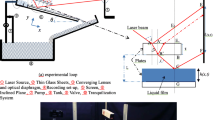Abstract
A direct experimental comparison was performed on two thin-oil-film skin-friction measurement techniques applied in short-duration, supersonic flow facilities. While both techniques use laser interferometry to measure the time rate of thinning of a thin-oil-film, one technique acquires data with a dual-laser-beam (DLB) configuration and the other gathers information with an expanded-laser-beam (ELB) configuration. The experimental investigation, as well as a theoretical uncertainty analysis, showed that when the data is limited due to short run-times, larger uncertainties or insufficient data for the determination of the skin-friction occurred with the DLB technique. Unlike the DLB method, the ELB technique can resolve the oil-film profile at a given instant, with two such measurements separated by a short time interval giving sufficient data to determine skin-friction. Thus the ELB technique is more suitable for short-duration facilities.
Similar content being viewed by others
Abbreviations
- Cf :
-
skin-friction coefficient
- dP/dx :
-
external-flow pressure gradient in the streamwise direction
- g :
-
gravitational acceleration
- h :
-
oil-film height at distance x
- i :
-
beam incidence angle
- l :
-
length
- M :
-
Mach number
- n o :
-
oil refraction index
- N :
-
interference fringe number
- Q :
-
volumetric flow rate per unit length
- r :
-
beam refraction angle
- Re :
-
Reynolds number
- s :
-
oil-film slope at a given time
- t :
-
time
- t o :
-
time origin
- u(y):
-
oil-film velocity profile
- V :
-
continuity-wave velocity
- x :
-
streamwise distance from oil-film leading-edge
- Δx :
-
Laser beam spacing of DLB configuration
- Δx p :
-
pixel spacing of CCD linear array
- y :
-
transverse coordinate normal to x
- θ :
-
angle of inclination of the test surface
- λ :
-
Laser wavelength
- μ :
-
absolute oil viscosity
- ν :
-
kinematic oil viscosity
- g9 :
-
oil density
- τ :
-
wall shear stress (skin-friction)
- (-):
-
averaged value
- (′):
-
corrected value
- DLB:
-
dual-laser-beam
- ELB:
-
expanded-laser-beam
- MEAS:
-
measured value
- NOM:
-
nominal value
- d :
-
downstream beam
- u :
-
upstream beam
- ∞:
-
free stream
References
Bandyopadhyay, P. R.; Weinstein, L. M. 1991: A reflection-type oil-film skin-friction meter. Exp. Fluids 11, 281–292.
Born, M.; Wolf, E. 1970: Principles of optics, 4th ed., pp. 281–287. Oxford: Pergamon Press.
Hubner, J. P. 1991: Comparison of two thin-oil-film laser interferometric skin-friction measurement techniques within compressible flow. M. S. Thesis, University of Florida.
Hubner, J. P.; Carroll, B. F. 1991: Uncertainty analysis on thin-oil-film skin-friction measurements in compressible flow. ICIASF 231–239.
Kim, K. -S. 1989: Skin friction measurements by laser interferometry in supersonic flows. Ph.D. Thesis, Pennsylvania State University.
Kim K, -S.; Settles, G. S. 1988: Skin friction measurements by laser interferometry in swept shock wave/turbulent boundary-layer interactions. AIAA Paper 88-0497.
Marquez Olivares, J. 1989: Absolutbestimmung der Wandschub-spannung mit Hilfe eines Interferometers. DFVLR-FB 89-13.
Monson, D. J.; Higuchi, H. 1981: Skin friction measurements by a dual-laser-beam interferometric technique. AIAA J. 19, 739–744.
Murphy, J. D.; Westphal, R. B. 1986: The laser interferometer skin-friction meter: A numerical and experimental study. J. of Physics E: Sci. Instr. 19, 744–751.
Monson, D. J.; Driver, D. M.; Szodruch, J. 1981: Application of a laser interferometric skin-friction meter in complex flows. ICIASF. 232–243.
Schlichting, H. 1979: Boundary-layer theory, 7th ed., pp. 715–723. New York: McGraw-Hill.
Seto, J.; Hornung, H. G. 1991: Internally mounted thin-oil-film skin friction meter-comparison with floating element method with and without pressure gradient AIAA Paper 91-0090.
Sigalla, A. 1965: Calibration of Preston probes in supersonic flow. AIAA J. 3, 1531.
Tanner, L. H. 1977a: A skin friction meter, using the viscosity balance principle, suitable for use with flat or curved metal surfaces. J. of Physics E: Sci. Instr. 10, 278–284.
Tanner, L. H. 1977b: A comparison of the viscosity balance and Preston tube methods of skin friction measurement. J. of Physics E: Sci. Instr. 10, 627–632.
Tanner, L. H.; Blows, L. G. 1976: A study of the motion of oil films on surfaces in air flow, with application to the measurement of skin friction. J of Physics E: Sci. Instr. 9. 194–202.
Wallis, G. B. 1969: One-dimensional two-phase flow, 1st ed., pp. 122–135. New York: McGraw-Hill.
Westphal, R. V.; Bachalo, W. D.; Houser, M. H. 1986: Improved skin friction interferometer. NASA TM 88216
Author information
Authors and Affiliations
Rights and permissions
About this article
Cite this article
Hubner, J.P., Carroll, B.F. Thin-oil-film interferometric skin-friction measurements in short-duration supersonic flow. Experiments in Fluids 15, 315–322 (1993). https://doi.org/10.1007/BF00223409
Received:
Accepted:
Issue Date:
DOI: https://doi.org/10.1007/BF00223409



